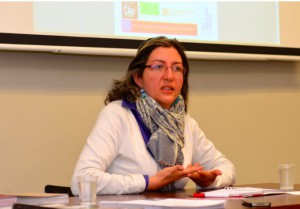FREE FLOW OF INFORMATION
an article by Pressenza International Press Agency (Reprinted according to creative commons licenses 4.0)
The presentation was organized by Colombia Human Rights Committee & Latin America Working Group Education Fund at The Graduate Center, CUNY in NYC.

Sonia Ines Goéz Orrego speaking at The Graduate Center, CUNY in NYC on March, 2nd 2015 (Image by David Andersson)
Sonia Ines Goéz Orrego is the executive director of CEDECIS, a community organization working in some of the most violent areas of Medellín. With two decades of experience in community organizing and building a culture of peace, she discussed how people have come together to prevent forced recruitment of young people by gangs, paramilitary, and guerrilla organizations, to train children and adolescents in nonviolence, and to build more resilient and peaceful communities. There are a lot of invisible borders in Medellín.” The 13th District, locally known as the Comuna 13, is known to be one of Medellin’s most troubled and dangerous districts, and is continually suffering from gang warfare and violence. Two powerful crime networks, the Caribbean-based Urabeños and Medellin’s own Oficina de Envigado crime syndicate, have vied for control of the neighborhood for years, causing repeated territorial wars in the streets of Comuna 8.”What’s an invisible border? It’s a place where nobody can be, only those who belong to the combo that controls the territory,”
CEDECIS’s experience is especially relevant today as the Colombian government and FARC guerrillas steadily advance the peace negotiations in Havana, Cuba, that would end the Western Hemisphere’s longest running conflict.
Ms. Goéz is also a representative of the Coordinación Colombia Europa Estados Unidos (CCEEUU), the main network of some 245 Colombian human rights and nongovernmental organizations.
What is happening in Colombia, Is peace possible?
This discussion question applies to the following articles:
Colombian villagers practice non-violent resistance
Legacy of a Nonviolent Political Leader: Governor Guillermo Gaviria of Colombia
Working for a Culture of Peace in the Valley of the Cauca, Colombia
Remise des Prix de la Fondation Chirac pour la prévention des conflits
Chirac Foundation Prize for Conflict Prevention
The University and the Peace Process in Colombia
La paz supera coyunturas y fronteras (Colombia y Venezuela)
Peace is not stopped by borders (Colombia and Venezuela)
Campesinos colombianos celebran primer acuerdo agrario de paz
Colombian Govt and FARC Reach Agreement on First Stage of Peace Talks
Colombia Campaña de la ONU “La Paz es mía”
UN Campaign in Colombia:
Presidente colombiano reactivará la Comisión Nacional de Paz
Colombian President to Reactivate National Peace Commission
FARC-EP y Gobierno colombiano avanzan en acuerdos para la paz
FARC-EP and Colombia Government advance in their peace accords
Colombia debe ser también la Nación más educada en derechos humanos: Presidente Santos
Colombia should also be the most educated nation in human rights : President Santos
Gabriel García Márquez and the peace process in Colombia
Colombia amanece con un presidente reelecto, esperanzada en la paz
Colombia awakens to hopes for peace with the re-election of their president
Mujer, ruralidad y memoria, entre los temas del congreso de paz (Bogotá, Colombia)
Women, rurality and historical memory among the themes of the Peace Congress (Bogotá, Colombia)
Sonia Ines Goéz Orrego on a speaking tour in the U.S. to share her experience building peace in Colombia
Pax Christi International – Peace Award 2015: Women, Peace and Security Collective for Reflection and Action (Colombia)